✅ FREE SHIPPING in the USA ✅ 30-DAY MONEY BACK GUARANTEE
✅ FREE SHIPPING in the USA ✅ 30-DAY MONEY BACK GUARANTEE
Welcome to our guide to creating a harmonious and stylish Japandi Feng Shui room.
Japandi style is a fusion of Japanese and Scandinavian design principles, resulting in a minimalist elegance that promotes tranquility and balance.
With its emphasis on natural materials, clean lines, and mindful simplicity, Japandi decor is perfect for those seeking a peaceful and inviting space.
In this article, we'll provide you with essential tips and insights to help you bring the Japandi aesthetic into your home.
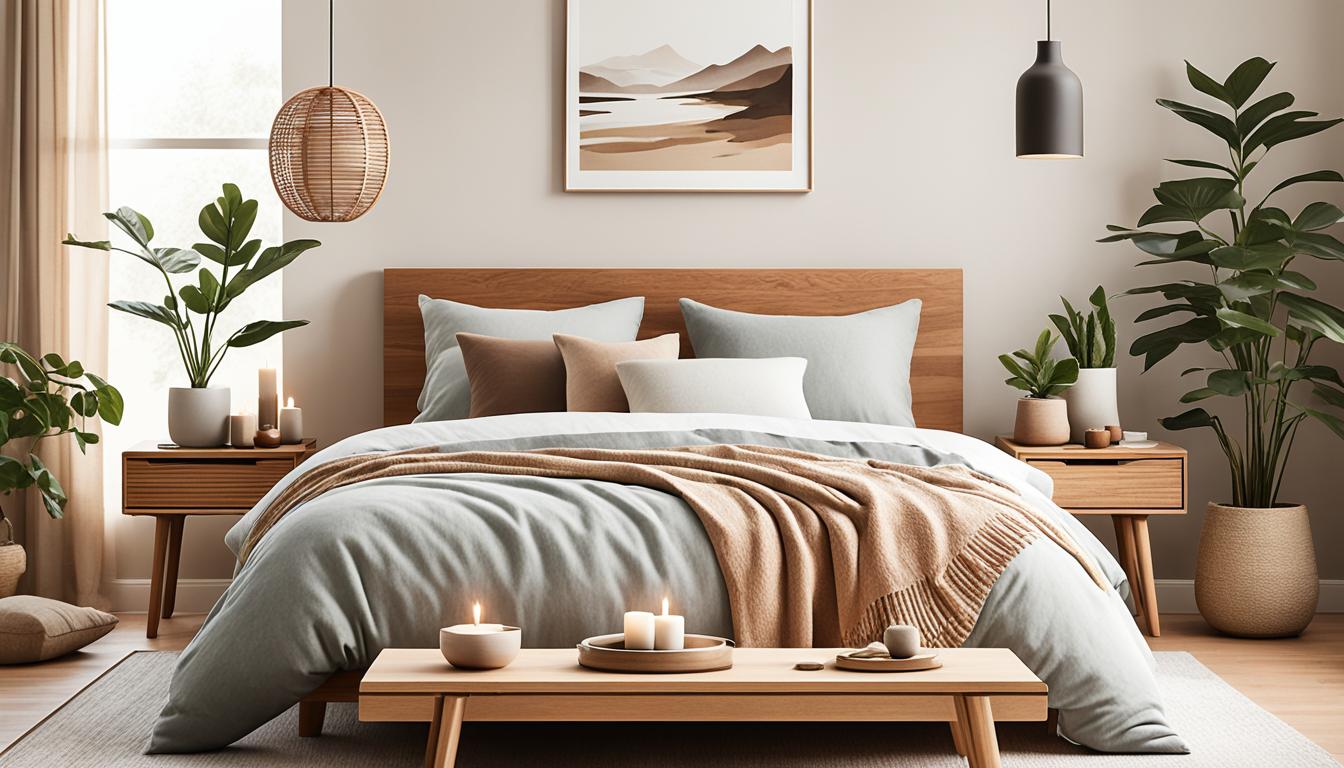
When it comes to interior design styles, the Japandi aesthetic has been gaining significant popularity in recent years.
Combining the minimalistic elegance of Scandinavian design with the calming and harmonious principles of Japanese design, Japandi offers a unique and captivating approach to creating beautiful living spaces.
The Japandi aesthetic, also known as Japandi style, revolves around simplicity, functionality, and natural elements.
It embraces clean lines, neutral color palettes, and a focus on creating balance and serenity in the home.
By blending the best of Scandinavian influences and Japanese design principles, Japandi interiors exude a sense of calm and tranquility.
To truly understand the Japandi aesthetic, it's essential to delve deeper into its defining design principles.
Let's explore each of these japandi design elements:
| Japandi Aesthetic | Key Design Principles |
|---|---|
| Minimalist Design | Stripping away clutter and unnecessary elements for a clean and organized space |
| Natural Materials | Embracing the use of wood, bamboo, and stone to bring nature indoors |
| Wabi-Sabi Philosophy | Appreciating imperfections and the beauty of natural wear and tear |
| Scandinavian Influences | Simple, functional, and light-filled interiors |
| Japanese Design Principles | Minimalism, attention to detail, and a sense of tranquility |
When it comes to Japandi Feng Shui room design, creating balance is key.
The harmonious fusion of Japanese minimalism and Scandinavian elegance is the essence of Japandi style.
By carefully considering the placement of furniture, incorporating natural elements, and embracing the principles of Feng Shui, you can create a truly balanced and serene space.
One important aspect of Japandi Feng Shui is the strategic arrangement of furniture and decor.
It's essential to create a layout that allows for a smooth flow of energy and promotes harmony in the room.
Avoid cluttering the space and instead opt for a minimalist approach, focusing on functional and purposeful pieces that contribute to the overall aesthetic.
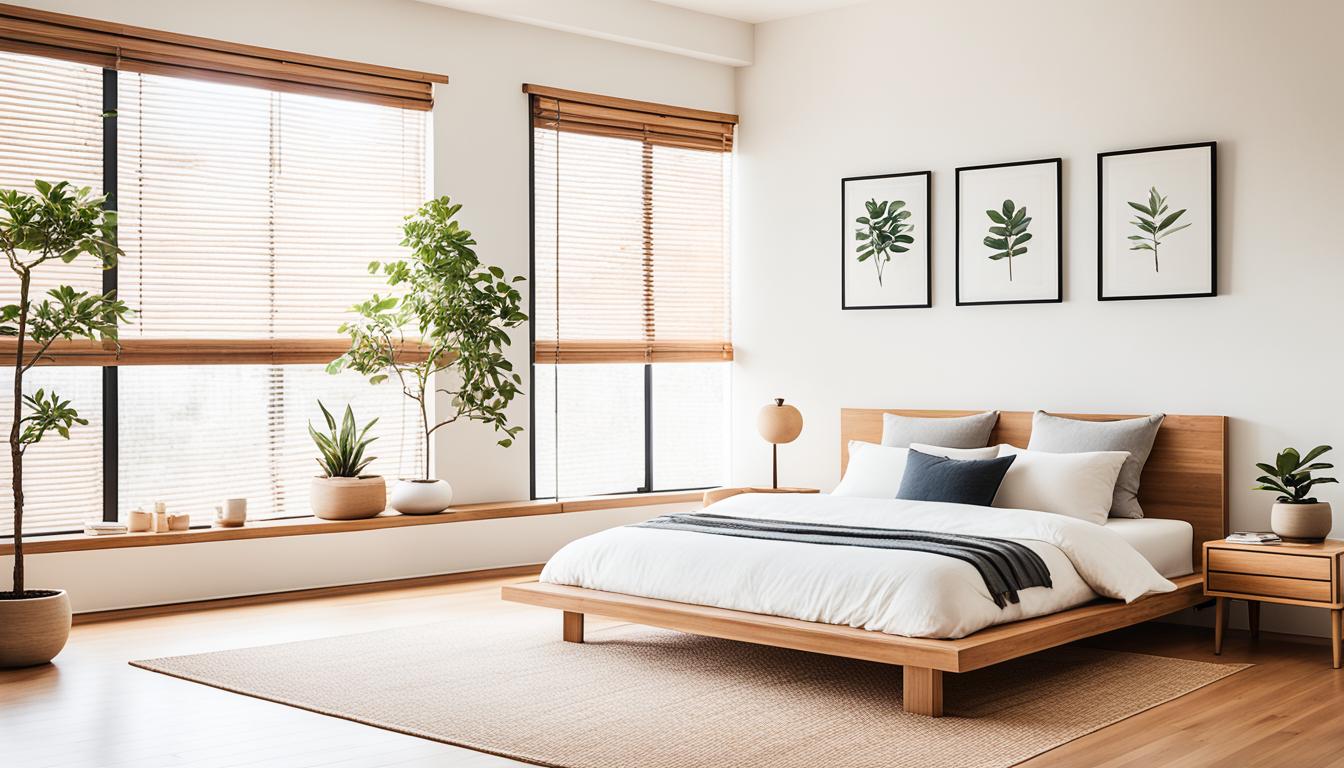
Incorporating natural elements is another key element in Japandi design.
By bringing elements such as wood, stone, and plants into the space, you can create a sense of balance and connection with nature.
These elements not only add visual interest but also bring a calming and grounding energy to the room.
Feng Shui principles play a significant role in Japandi room design.
By considering factors such as color, lighting, and placement of furniture, you can optimize the flow of energy and create a harmonious environment.
For example, using soft, warm lighting can create a cozy and serene ambiance, while strategic placement of furniture can promote positive energy circulation.
In summary, Japandi Feng Shui room design is all about creating balance and harmony in the space.
By carefully considering the placement of furniture, incorporating natural elements, and following the principles of Feng Shui, you can achieve a truly harmonious and tranquil atmosphere in your Japandi-inspired room.
| Japandi Feng Shui Room Design Tips |
|---|
| Opt for a minimalist approach, focusing on functional and purposeful furniture pieces |
| Incorporate natural elements such as wood, stone, and plants to create a sense of balance |
| Consider the principles of Feng Shui, including color, lighting, and furniture placement |
| Avoid clutter and create a layout that promotes a smooth flow of energy |
| Use soft, warm lighting for a cozy and serene ambiance |
When it comes to designing a Japandi room, there are key elements that contribute to creating a harmonious and balanced space.
Embracing natural materials and textures, as well as incorporating the Wabi-Sabi philosophy, are essential components of this interior design style.
One of the defining characteristics of Japandi style is the use of natural materials such as wood, bamboo, and stone.
These elements bring a sense of warmth and tranquility to the room, while also connecting the space with the natural world.
Incorporating textures like rattan, linen, and woven fabrics further enhances the organic and tactile experience of a Japandi room.
The Wabi-Sabi philosophy, rooted in Japanese aesthetics, celebrates imperfection, impermanence, and the beauty of the natural world.
In a Japandi room, embracing Wabi-Sabi means choosing imperfect and weathered items that showcase the passage of time.
Handcrafted ceramics with uneven edges, vintage furniture with visible wear, and handmade textiles with organic patterns all contribute to the serene and authentic atmosphere of a Japandi space.
By creating a balance between Scandinavian minimalism and Japanese elegance, Japandi style offers a harmonious fusion of cultures and design philosophies.
The use of natural materials and textures, along with the incorporation of the Wabi-Sabi philosophy, brings a sense of authenticity, tranquility, and simplicity to any Japandi room.
When it comes to creating a soothing ambiance in your Japandi-style room, choosing the right color scheme is essential.
The harmonious blend of Scandinavian minimalism and Japanese design principles calls for a palette that evokes tranquility and simplicity.
Inspired by nature, Japandi interiors often feature soft, earthy tones, muted pastels, and neutral hues.
These colors create a serene and calming atmosphere, allowing you to unwind and find peace in your space.
Consider incorporating shades of warm greys, soft blues, gentle greens, and warm beiges into your color scheme.
Another popular approach is to use contrasting colors to add depth and visual interest to your Japandi room.
| Light Colors | Dark Colors |
|---|---|
| Beige | Charcoal |
| Light Grey | Navy |
| Soft Blue | Forest Green |
| Light Green | Deep Brown |
By combining light and dark colors in your Japandi room, you can create a visually appealing and balanced space.
The light colors provide a sense of openness and airiness, while the dark colors add depth and contrast.
This balance helps to maintain the soothing ambiance characteristic of the Japandi style.
Remember, the color scheme sets the foundation for the overall atmosphere and aesthetic of your room.
When choosing colors for your Japandi space, opt for those that resonate with your personal preference and align with the principles of minimalist elegance and tranquility.
When it comes to Japandi interiors, selecting the right furniture pieces is crucial in achieving the minimalist design and functional aesthetic that defines this style.
In this section, we will explore the essential furniture pieces that contribute to the harmonious atmosphere of Japandi spaces.
In Japandi interiors, less is more. Choose furniture that embodies the essence of simplicity and clean lines.
Opt for pieces made from natural materials such as wood or rattan to create a sense of warmth and connection to nature.
Minimalist design principles focus on essentiality, so prioritize functionality when selecting furniture pieces.
Invest in multifunctional furniture that serves more than one purpose to maximize space efficiency.
For example, a sleek sofa with built-in storage or a coffee table that doubles as a workspace can help keep your Japandi room clutter-free while maintaining style and practicality.
Incorporating Feng Shui principles in the arrangement of furniture plays a vital role in creating a harmonious Japandi space.
Strategic placement allows for a balanced and flowing energy flow throughout the room.
Consider the following tips:
By combining essential furniture pieces with strategic placement, you can achieve a Japandi interior that exudes tranquility and aesthetic perfection.
In a Japandi space, each accessory serves a purpose, contributing to the overall harmony and functionality of the room.
When selecting decor for your Japandi-inspired space, it's essential to prioritize clean lines and minimalist aesthetics.
To maintain the clean and refined look of your Japandi decor, opt for items with clean lines and simple designs.
Avoid cluttering your space with ornate or overly decorative accessories.
Look for objects that exude simplicity and elegance, aligning with the minimalist philosophy of Japandi style.
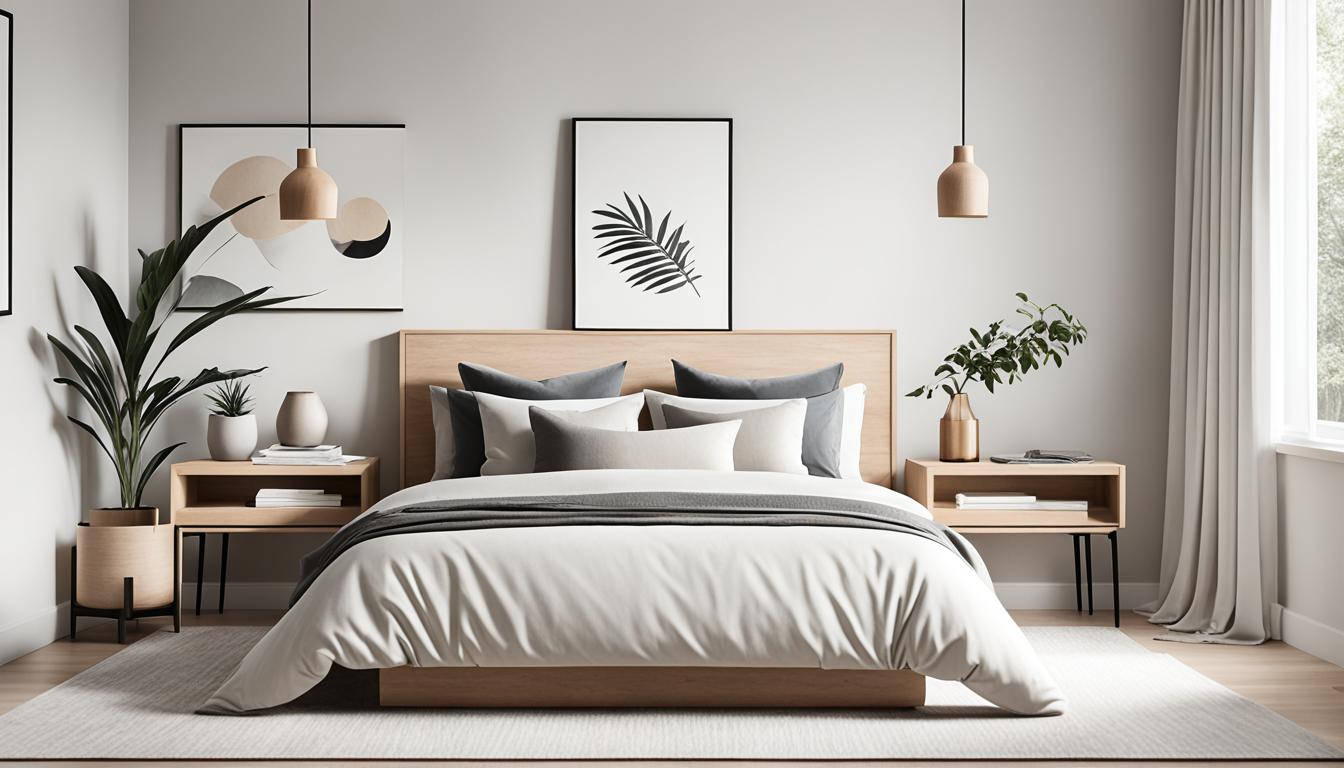
In addition to their visual appeal, every object in your Japandi space should serve a functional purpose.
Choose accessories that not only enhance the aesthetics but also provide practical usage.
This approach ensures that each item contributes to the overall functionality and utility of the space, promoting a sense of efficiency and organization.
By accessorizing with purpose and incorporating decor with clean lines, you can create a Japandi space that is both visually pleasing and highly functional.
Each accessory carefully selected will enhance the overall harmony of your room, staying true to the principles of Japandi style.
Effective lighting plays a crucial role in creating a harmonious and serene Japandi Feng Shui room.
By utilizing natural light and incorporating soft, warm lighting, you can cultivate a calm environment and enhance the evening serenity of your space.
One of the key lighting strategies in Japandi Feng Shui is harnessing the power of natural light.
Sunlight not only illuminates a room but also brings in positive energy.
Ensure that your windows are unobstructed to maximize the flow of natural light.
Consider using sheer curtains or blinds to filter the light, creating a soft and gentle ambiance.
Positioning your furniture in a way that allows natural light to reach every corner of the room can create an open and inviting atmosphere.
Take advantage of reflective surfaces like mirrors and light-colored walls to bounce and amplify natural light throughout the space.
In the evening, when natural light dims, it's essential to create a serene ambiance with soft, warm lighting.
Select lighting fixtures that emit a cozy glow rather than harsh, bright lights.
Opt for warm-toned light bulbs with a lower color temperature to create a soothing atmosphere.
Strategically place table lamps, floor lamps, and wall sconces to distribute the soft lighting evenly across the room.
This will help establish a sense of tranquility and relaxation, perfect for unwinding at the end of the day.
In Japandi decor, the seamless integration of natural elements into the interior design is key to achieving a harmonious and peaceful atmosphere.
By bringing nature indoors, you can create a space that promotes tranquility and connection with the natural world.
Incorporating organic materials, earthy colors, and greenery can help enhance the Japandi aesthetic and bring a sense of balance and serenity to your room.
One effective way to introduce natural elements into your Japandi space is through the use of plants.
Adding a variety of indoor plants not only brings life into the room but also improves air quality and adds visual interest.
Choose plant species that thrive indoors and require minimal maintenance.
Position them strategically throughout the room to create a sense of balance and harmony.
Another way to incorporate nature is by using natural materials and textures in your furniture and decor.
Opt for sustainable materials like bamboo, rattan, or reclaimed wood for tables, chairs, and shelving units.
These materials not only add warmth and texture but also align with the eco-friendly principles of Japandi design.
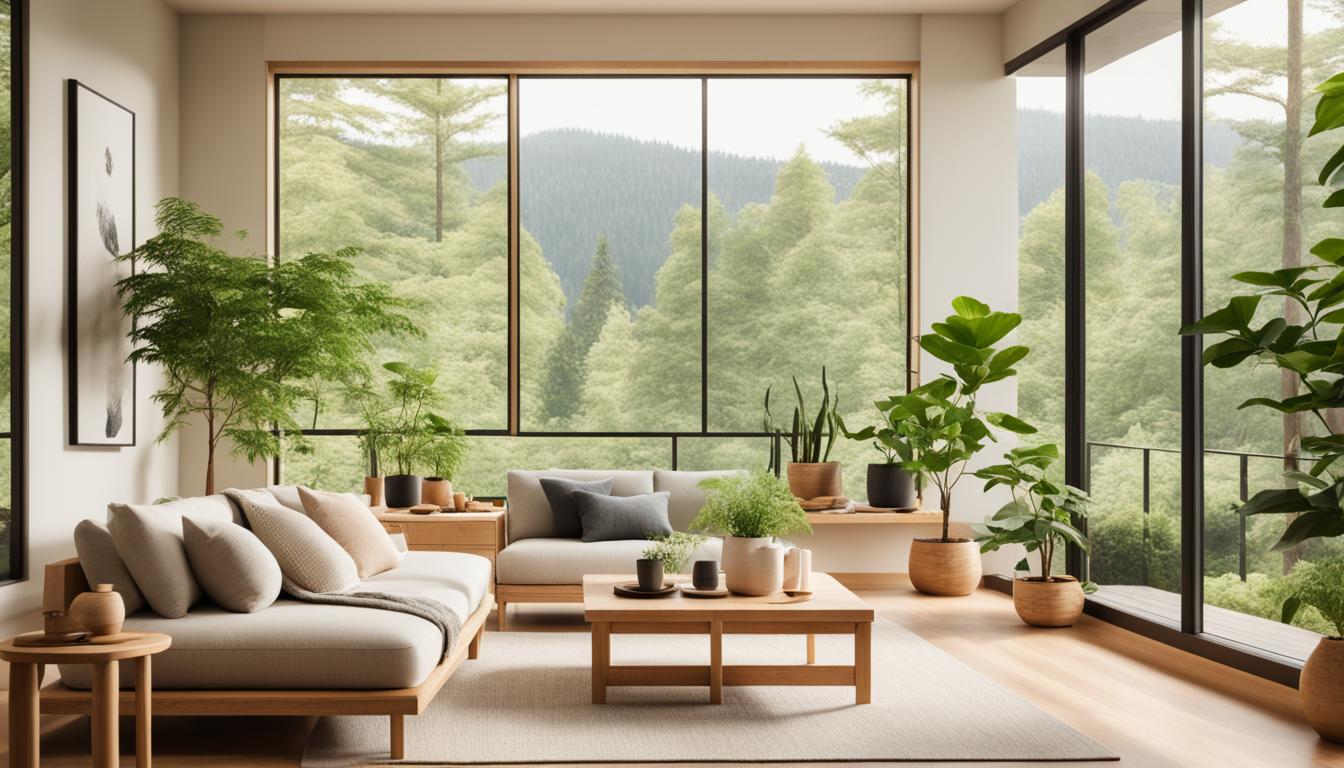
To further enhance the natural feel, choose textiles and accessories made from organic fibers such as linen and cotton.
Incorporate earthy colors inspired by nature, such as muted greens, browns, and neutrals, for a soothing and grounding effect.
Creating a connection with the outdoors is also about embracing natural light.
Keep your windows unobstructed to allow ample natural light to fill the room.
Consider using sheer curtains or blinds that can be easily adjusted to control the amount of light and privacy, while still maintaining a sense of openness and connection to the outside.
By bringing nature indoors with Japandi decor, you can create a space that evokes tranquility, balance, and a deep appreciation for the natural world.
Embrace the beauty of organic materials, incorporate greenery, and let natural light fill the room, and you'll create a space that is both aesthetically pleasing and nurturing for your well-being.
Creating a cozy and inviting atmosphere is an essential aspect of Japandi style.
The combination of Japanese principles and Scandinavian minimalism offers a unique approach to cultivating coziness in your space.
By incorporating textiles and soft furnishings, along with smart storage solutions, you can achieve a cozy minimalism that exudes warmth and tranquility.
Textiles play a crucial role in adding warmth and comfort to a Japandi room.
Consider incorporating soft blankets, plush cushions, and cozy rugs made from natural materials like cotton and wool.
These elements not only add texture to the space but also create a sense of coziness that invites relaxation and serenity.
When selecting textiles for your Japandi room, opt for earthy tones and subtle patterns that align with the minimalist aesthetic.
Stick to a cohesive color palette that includes muted shades of beige, gray, and brown to create a soothing and harmonious ambiance.
Incorporating smart storage solutions is key to maintaining an uncluttered and organized Japandi space.
Look for furniture pieces that offer hidden compartments or built-in storage to keep your belongings out of sight.
Utilize wall-mounted shelves and floating cabinets for displaying minimalistic decor and keeping surfaces clear.
Invest in multi-functional furniture that serves a dual purpose, such as ottomans with hidden storage or coffee tables with built-in drawers.
These smart storage solutions not only contribute to the minimalist aesthetic but also help create a serene and clutter-free environment, promoting a sense of calmness and tranquility.
By striking the right balance between cozy textiles and smart storage solutions, you can create a Japandi space that radiates warmth, simplicity, and harmony.
Embrace the minimalist elegance of Japandi style while incorporating elements that add comfort and functionality, resulting in a cozy sanctuary you can truly relax in.
| Benefits of Cozy Minimalism in Japandi Style | Examples of Textiles and Soft Furnishings | Smart Storage Solutions |
|---|---|---|
| Creates a warm and inviting atmosphere | Soft blankets | Furniture with hidden compartments |
| Promotes relaxation and serenity | Plush cushions | Wall-mounted shelves |
| Contributes to a harmonious and minimalist aesthetic | Cozy rugs made from natural materials | Floating cabinets |
| Helps maintain an uncluttered and organized space | Earthy tones and subtle patterned textiles | Multi-functional furniture |
In a Japandi room, the carefully curated wall art plays a significant role in enhancing the overall aesthetic.
Embracing the principles of simplicity, the art should reflect the harmonious blend of Scandinavian and Japanese influences.
Opt for minimalist and abstract pieces that evoke a sense of calmness and balance.
Consider using black and white photographs or line drawings to emphasize clean lines and understated elegance.
By selecting wall art that speaks to simplicity, you can create a focal point while maintaining the minimalist ambiance of the Japandi style.
While simplicity is key in a Japandi room, it's important to infuse the space with mindful personal touches to make it truly your own.
Add elements that reflect your personality and interests, but ensure they are integrated harmoniously into the overall design.
For example, if you love plants, incorporate a few carefully chosen potted plants to bring in a touch of nature and tranquility.
Display meaningful objects or souvenirs from your travels, carefully arranging them to maintain the minimalist aesthetic.
By infusing your personality mindfully, you can create a space that is not only visually appealing but also showcases your individuality within the Japandi style.
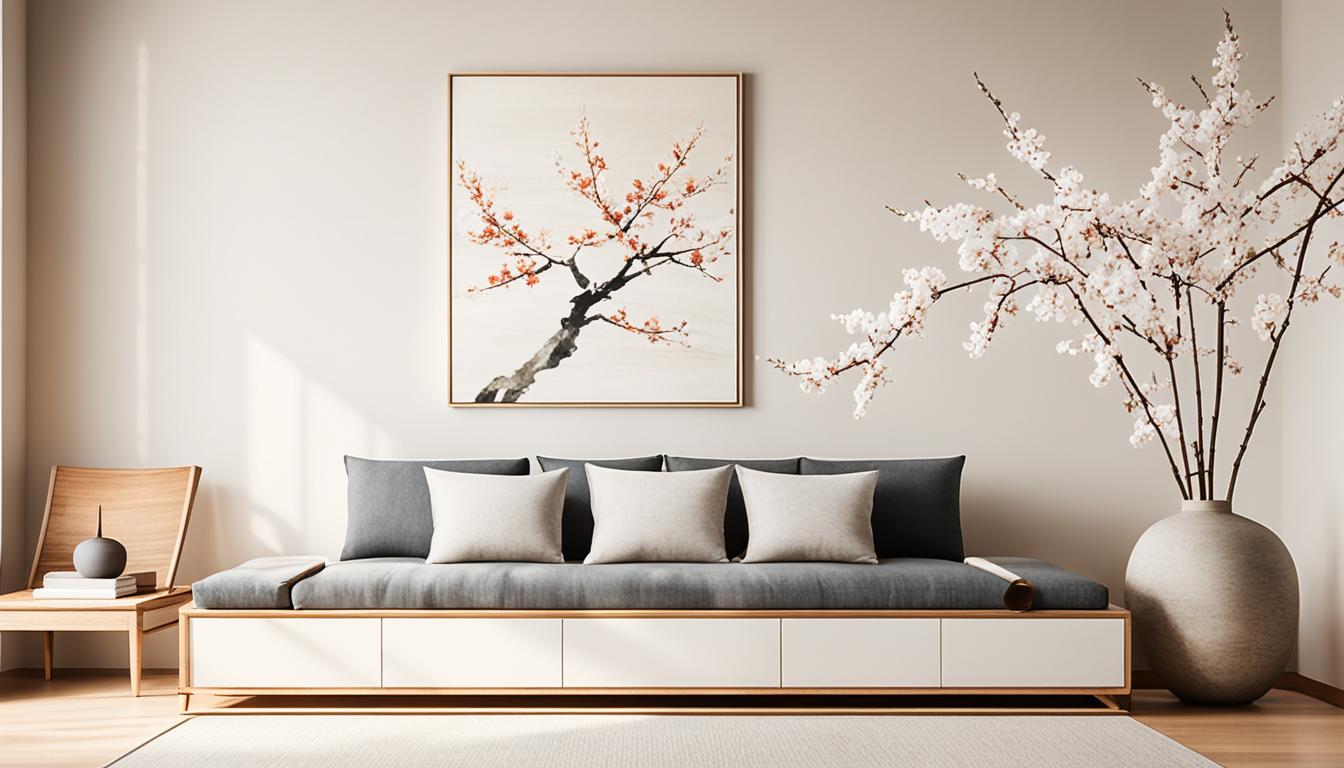
| Benefits of Curating Wall Art in a Japandi Room | Tips for Infusing Personality in a Japandi Space |
|---|---|
| 1. Enhances the overall aesthetic | 1. Select meaningful objects or souvenirs |
| 2. Evokes a sense of calmness and balance | 2. Integrate personal touches harmoniously |
| 3. Creates a focal point | 3. Display items that reflect your interests |
| 4. Maintains the minimalist ambiance | 4. Carefully arrange objects to maintain the aesthetic |
Now that you understand the principles and aesthetics of Japandi design, it's time to adopt Japandi Feng Shui practices to create a harmonious and balanced space.
By incorporating effortless flow and order with Japandi layouts, as well as maintaining a Japandi aesthetic with daily habits, you can fully embrace this unique interior design style.
Japandi layouts emphasize a sense of spaciousness and simplicity, allowing energy to flow freely throughout the room.
To achieve this, start by decluttering your space and eliminating any unnecessary items.
Utilize minimalistic furniture arrangements and consider the placement of each piece to promote a sense of balance and ease of movement.
Additionally, incorporate natural light to create a calm and inviting atmosphere.
Consider using light-colored curtains or blinds that allow light to filter through while maintaining privacy.
This will enhance the airy and open feel of the room.
To truly embrace the Japandi lifestyle, it's important to incorporate daily habits that align with the minimalist and mindful approach of Japandi design.
Start by practicing regular decluttering sessions to prevent accumulation of unnecessary items.
Embrace the concept of "one in, one out," meaning for every new item you bring into the space, remove one that no longer serves a purpose.
Another essential habit is to create a daily ritual for tidying up and organizing.
Dedicate a few minutes each day to put things back in their designated places and maintain a clutter-free environment.
This will help maintain the peaceful and uncluttered aesthetic that is characteristic of Japandi design.
Additionally, embrace natural materials and incorporate plants into your space.
Not only do plants add a touch of nature and tranquility, but they also help to purify the air and promote a sense of well-being.
By adopting Japandi Feng Shui practices and incorporating effortless flow and order into your room layout, as well as maintaining a Japandi aesthetic with daily habits, you can create a space that reflects the beauty and simplicity of this unique design style.
Embrace the principles of Japandi and let your living space become a serene sanctuary that nurtures both your mind and body.
Now that you have read the above article, maybe you still have a couple of questions on this topic, so we will answer these questions below.
Japandi Feng Shui room design is a harmonious decor style that blends the simplicity and elegance of both the Japandi and Feng Shui principles.
It combines the minimalist interior design of Japanese aesthetics with the functional and balanced approach of Scandinavian design influences.
Some interior decorating tips for a Japandi room include selecting furniture and decor items with clean lines, choosing objects that have a functional purpose, utilizing natural light to create a calm environment, incorporating soft and warm lighting for evening serenity, bringing nature indoors through the use of plants and natural elements, and curating art and personal touches that align with the simplicity and mindfulness of the Japandi aesthetic.
Choose Mojo Boutique to buy furniture and decor items to create japandi room.
You can incorporate Feng Shui practices into a Japandi room by ensuring an effortless flow and order in your layout, considering factors such as furniture placement and room arrangement.
Additionally, maintaining a Japandi aesthetic with daily habits and intentional actions can help promote a harmonious and balanced energy in the room.
In conclusion, creating a Japandi Feng Shui room allows you to blend the best of two design styles - the minimalist elegance of Scandinavian design and the harmonious and nature-inspired principles of Japanese design.
By incorporating key elements such as natural materials, embracing a soothing color scheme, and selecting minimalist furniture pieces, you can achieve a balanced and serene space.
Accessorizing with purpose and incorporating elements of nature further enhances the Japandi aesthetic.
By utilizing natural light and strategic lighting strategies, you can create a calming environment throughout the day.
Additionally, cultivating coziness without clutter and curating meaningful artwork and personal touches add warmth and personality to your Japandi room.
Adopting Japandi Feng Shui practices such as promoting effortless flow and order in your room layout, as well as maintaining the minimalist aesthetic through daily habits, will help you create a truly harmonious and balanced space.
Whether you're starting from scratch or looking to enhance your current decor, Japandi Feng Shui offers a beautiful and tranquil style that promotes a sense of well-being and relaxation.
So why not embrace the Japandi Feng Shui style and bring minimalist elegance and nature-inspired design into your space?
By blending these styles, you can create a truly unique and harmonious environment that reflects your personal taste and enhances your well-being.


